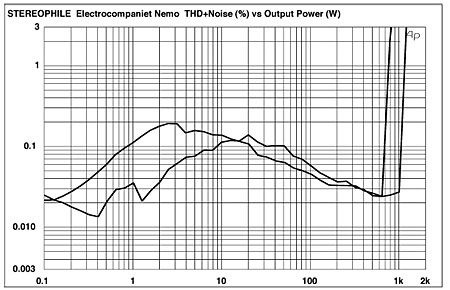| Columns Retired Columns & Blogs |
Electrocompaniet Nemo monoblock power amplifier Measurements
Sidebar 3: Measurements
All measurements presented here are for balanced operation. Following its 1/3-power, one-hour preconditioning test, the Electrocompaniet Nemo's chassis was quite warm to the touch, but not uncomfortably so. The amp's input impedance measured 301k ohms (595k ohms unbalanced, using the supplied adaptor). The output voltage was rendered slightly unstable by infrasonic noise—not enough to be of concern during normal operation, but enough to render such high input-impedance measurements less than fully reliable. I can say, however, that the Nemo has a far higher input impedance than do most solid-state power amplifiers.
The output impedance measured higher than specified, at between 0.17 and 0.23 ohms, depending on frequency and the load impedance used to derive the measurement. These are moderately high values for a solid-state amplifier—enough to cause, into real loudspeaker loads, a small frequency-response deviation that might be marginally audible.
The Nemo is noninverting when driven balanced with pin 2 positive, or via the unbalanced adaptor. DC offset measured 0.4mV. The Electrocompaniet's voltage gain into 8 ohms measured a high 34.3dB. The signal/noise ratio (ref. 1W into 8 ohms) measured 89.6dB over a 22Hz–22kHz bandwidth, 80.2dB from 10Hz to 50kHz, and 93.3dB A-weighted.
Fig.1 shows the Nemo's frequency response, with a 0.25dB error visible into our simulated speaker load. The 10kHz squarewave response (fig.2) exhibits a good risetime, with a slight rounding of the leading edge—very common among even the best amplifiers—and no overshoot or ringing. (The 1kHz squarewave response, not shown, is nearly perfect.) The THD+noise percentage vs frequency curves are plotted in fig.3. The results show increasing levels of distortion at lower load impedances and higher frequencies, but the distortion overall remains quite low. The distortion increases slightly when the amplifier is driven unbalanced (not shown), but remains insignificant at these low power levels.

Fig.1 Electrocompaniet Nemo, frequency response at (from top to bottom at 6kHz): 2W into 4 ohms, 1W into 8 ohms, and 2.828V into simulated loudspeaker load, (0.5dB/vertical div., right channel dashed).

Fig.2 Lexicon MC-1, ADC frequency response at 1V input (gain set manually to "–3"; 0.5dB/vertical div., right channel dashed).

Fig.3 Electrocompaniet Nemo, THD+noise (%) vs frequency at (from top to bottom at 4kHz): 4W into 2 ohms, 2W into 4 ohms, 2.83V into simulated loudspeaker load, and 1W into 8 ohms (right channel dashed).
Fig.4 shows the waveform of the Nemo's distortion at 2W into 4 ohms: third-harmonic distortion clearly predominates. The distortion waveforms are very similar at 1W into 8 and 2 ohms (not shown). Because of the Nemo's very high power output and the limitations of our test load, I looked at the 50Hz spectrum of 400W into 8 ohms instead of the usual 4 ohms (fig.5). All artifacts are below –80dB (0.01%) with, again, the third-harmonic highest in level.

Fig.4 Electrocompaniet Nemo, 1kHz waveform at 2W into 4 ohms (top), distortion and noise waveform with fundamental notched out (bottom, not to scale).

Fig.5 Electrocompaniet Nemo, spectrum of 50Hz sinewave, DC–1kHz, at 400W into 4 ohms (linear frequency scale).
Fig.6 shows the Nemo's response, at 376W into 8 ohms, to a combined 19+20kHz signal—the intermodulation products resulting from an input signal consisting of an equal combination of these two frequencies. (Visible clipping is present above this power level with this input signal.) Again, the resulting IM distortion is below –80dB (0.01%) everywhere, except at 18kHz (and 21kHz), where it is a still-low –74dB (0.02%).

Fig.6 Electrocompaniet Nemo, HF intermodulation spectrum, DC–22kHz, 19+20kHz at 376W into 4 ohms (linear frequency scale).
It was during the HF intermodulation measurement that a brief overload from a too-high input shut down the Nemo. I lowered the input level and the amp returned to normal operation. However, there was the distinct smell of a burnt part, possibly a resistor. The smell dissipated, and the amplifier continued to operate normally, with consistently good measurements. When I then retested the Nemo, its frequency response was unchanged, but its THD+noise readings seemed a bit unstable, giving different results at different times but always remaining well below 0.1%. (The measurements shown in fig.3 were the lowest obtained after the incident.)
The Nemo's 1kHz, THD+noise percentage vs output power curves are shown in fig.7. The amplifier's high power output is obvious. Again, because of the Nemo's high power and the limited capability of our test load, I took no readings into 2 ohms. The only oddity in these curves is the rise in distortion at lower power. (These measurements were taken before the overload described above.) The discrete clipping measurements (1% THD+noise, 1kHz) indicated a power output of 757W (28.8dBW) into 8 ohms, and 1145W (27.6dBW) into 4 ohms (the power line dropped from 115V to 112V during this test).

Fig.7 Electrocompaniet Nemo, distortion (%) vs continuous output power into (from bottom to top below 10W) 8 ohms and 4 ohms.
This is an excellent set of measurements for a very high-powered amplifier.—Thomas J. Norton
- Log in or register to post comments




































